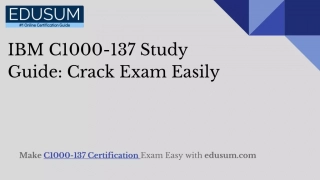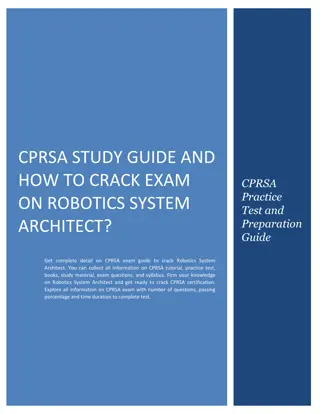Exam 2 Review and Study Guide with Test Strategies
Prepare for your Exam 2 with detailed study tips, material breakdown, test strategies, and in-class activities. Utilize lecture slides, textbooks, and notes to study effectively. Enhance your understanding of deep ocean circulation, modeling the ocean-atmosphere system, and the carbon cycle overview. Maximize your preparation time and boost your confidence for the exam!
Download Presentation

Please find below an Image/Link to download the presentation.
The content on the website is provided AS IS for your information and personal use only. It may not be sold, licensed, or shared on other websites without obtaining consent from the author. Download presentation by click this link. If you encounter any issues during the download, it is possible that the publisher has removed the file from their server.
E N D
Presentation Transcript
Exam 2 50 questions 1 hour and 20 minutes to complete exam Multiple choice Lecture slides and notes
What material to study? Follow the study points posted on UBLearns Lecture Material Textbook chapters if you have any question on the lecture material Your own notes
Study Tips Go through the study points and lecture slides Read the chapters actively if you do not fully understand the lecture slides or notes Find a study buddy Use flash cards Email me if you still have questions
Test strategies Usually 1 or 2 answers that are totally incorrect, and then 1 that might sound like it is correct but is not. Studying thoroughly allows you to distinguish between the answer that looks correct and the answer that is correct. Because of the above TAKE YOUR TIME! Don t rush through it, because you may get tripped up by those answers that look correct but are not. ALWAYS put an answer. 25% chance you will get it right by guessing.
In-class activity Imagine you are the professor, post a multiple choice question. This trains you to anticipate the types of questions, so you can focus on what to study Gets you into that type of thinking
Deep ocean circulation The formation of deep water Thermohaline conveyor belt The formation of thermohaline conveyor belt
Modeling the ocean atmosphere system (GCMs) The type of models with the most precise and quantitative predictions The vertical layers in the General Circulation Models Calculations made in 3 D grid cells GCMs prediction between 2000 and 2100 AD Validation of GCMs predictions
Carbon cycle overview The planets in the solar system Earth s carbon reservoirs The chemical interaction between carbon and oxygen Photosynthesis Products of respiration The residence time for carbon in the reservoir Net photosynthesis = gross photosynthesis respiration Net Primary Productivity in Buffalo Producers and consumers Marine productivity
Carbon cycles Source of carbon emissions due to anthropogenic activity Carbonate rocks Fossil fuel reserves Igneous rock, sedimentary rock, and metamorphic rock Carbon dioxide dissolves into ocean water Silicate weathering
Origin of Earth Geological time: Precambrian Eon and Phanerozoic Eon. absolute geological dating aftermath of the collapse of solar nebula Earth s core, mantle, and crust Earth s moon (Luna) tidal forces linked to the phases of the Moon Bombardment period Aftermath of Earth s collision with a Mars-sized planet
Origin of Life Oldest rocks Oldest fossils Miller-Urey experiment Three domains of life Reason that deep-sea hydrothermal vents are the most likely location where life developed
The rise of atmospheric oxygen early life, cyanobacteria, evidence, and timing Third major forms of life Oldest evidence of photosynthesis States of iron Oxygen levels inferred from Banded Iron Formations and Redbeds Delayed rise of atmospheric oxygen
The rise of atmospheric oxygen carbon isotopes, oxygen in Phanerozoic Eon, fire, and ozone The reason carbon isotopes in ocean sediments useful for tracking changes in atmospheric carbon and oxygen content carbon isotope uptake patterns reasons that atmospheric oxygen increased during the Carboniferous Period Fire and the stability of atmospheric oxygen concentration Ozone formation























